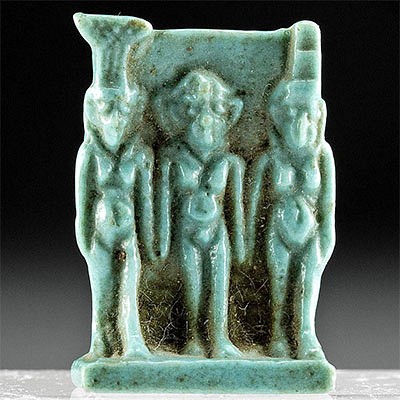Egyptian Painted Wood Legs from Royal Seat / Stool
Lot 12
About Seller
Artemis Gallery
686 S Taylor Ave, Ste 106
Louisville, CO 80027
United States
Selling antiquities, ancient and ethnographic art online since 1993, Artemis Gallery specializes in Classical Antiquities (Egyptian, Greek, Roman, Near Eastern), Asian, Pre-Columbian, African / Tribal / Oceanographic art. Our extensive inventory includes pottery, stone, metal, wood, glass and textil...Read more
Estimate:
$2,200 - $3,300
Absentee vs Live bid
Two ways to bid:
- Leave a max absentee bid and the platform will bid on your behalf up to your maximum bid during the live auction.
- Bid live during the auction and your bids will be submitted real-time to the auctioneer.
Bid Increments
| Price | Bid Increment |
|---|---|
| $0 | $25 |
| $300 | $50 |
| $1,000 | $100 |
| $2,000 | $250 |
| $5,000 | $500 |
| $10,000 | $1,000 |
| $20,000 | $2,500 |
| $50,000 | $5,000 |
| $100,000 | $10,000 |
| $200,000 | $20,000 |
About Auction
By Artemis Gallery
Aug 5, 2021
Set Reminder
2021-08-05 10:00:00
2021-08-05 10:00:00
America/New_York
Bidsquare
Bidsquare : VARIETY SALE | Antiquities & Ethnographic Art
https://www.bidsquare.com/auctions/artemis-gallery/variety-sale-antiquities-ethnographic-art-7292
Featuring classical antiquities, ancient and ethnographic art from cultures encompassing the globe. Egyptian, Greek, Roman, Etruscan, Near Eastern, Asian, Pre-Columbian, Native American, African / Tribal, Oceanic, Spanish Colonial, Russian, Fossils, Fine Art, more! Artemis Gallery info@artemisgallery.com
Featuring classical antiquities, ancient and ethnographic art from cultures encompassing the globe. Egyptian, Greek, Roman, Etruscan, Near Eastern, Asian, Pre-Columbian, Native American, African / Tribal, Oceanic, Spanish Colonial, Russian, Fossils, Fine Art, more! Artemis Gallery info@artemisgallery.com
- Lot Description
Ancient Egypt, Late Dynastic period, ca. 664 to 332 BCE. A special pair of finely carved and painted wooden legs, perhaps from a throne, an auxiliary royal seat, or a stool intended for a statue of a divinity. According to Nora Scott, former Associate Curator of Egyptian Art of the Metropolitan Museum of Art, lions were depicted, because it was thought that the sitter shared and/or derived qualities from the courageous King of Beasts. These legs still possess remarkable detailing of the wild felines' eyes, nose, muzzle, and coats, finely carved and painted on gesso-covered fabric. The curvilinear pattern embellishing the leonine bodies and the expressive visages of the wild felines delineated in red, yellow, and grey pigments, imbue the legs with a lively, almost animated quality. Size: 17" W x 20.875" H (43.2 cm x 53 cm) - both legs as arranged on stand; 25.125" H (63.8 cm) on included custom stand.
Perhaps the most famous ancient Egyptian chair was King Tut's Throne - among the most luxurious treasures discovered by Howard Carter in 1922. It is oftentimes referred to as Tut's Golden Throne; however, this may be a misnomer as scholars believe that the seat was actually an auxiliary royal chair rather than the boy king's throne. Interestingly, the so-called King Tut Throne was not made of solid gold as some have surmised, but rather was comprised of wood overlaid with sheets of precious gold and silver and further decorated with glaze, colored glass, and semi-precious stones. Given this, just imagine how these wooden legs were once adorned!
For more discussion of Egyptian furniture read an article by former Associate Curator of Egyptian Art Nora Scott entitled "Our Egyptian Furniture" (Metropolitan Museum of Art Bulletin, Volume XXIV, Number 4, December 1965). A miniature bronze model throne for a deity with legs depicting lions in the front and lion legs in the rear in the collection of the Metropolitan Museum of Art (accession number 64.308) is illustrated in this article as well (p. 148, figure 49).
Provenance: private J.H. collection, Beaverton, Oregon, USA, acquired in 2016; ex-Relics of the Nile, Lexington, Kentucky, USA, before 2011
All items legal to buy/sell under U.S. Statute covering cultural patrimony Code 2600, CHAPTER 14, and are guaranteed to be as described or your money back.
A Certificate of Authenticity will accompany all winning bids.
Replace: PLEASE NOTE: Due to recent increases of shipments being seized by Australian & German customs (even for items with pre-UNESCO provenance), we will no longer ship Replace: most antiquities and ancient Chinese art to Australia & Germany. For categories of items that are acceptable to ship to Australia or Germany, please contact us directly or work with your local customs brokerage Replace: firm.
Display stands not described as included/custom in the item description are for photography purposes only and will not be included with the item upon shipping.
#150510Expected surface wear with loss to pigmented gesso on linen decoration, age cracks, and losses to peripheries, dowels and slats (though there are still some remains of these), and high-pointed areas as shown. Overall the forms are very nice and still retain wonderful details.Condition
- Shipping Info
-
All shipping is handled in-house for your convenience. Your invoice from Artemis Gallery will include shipping calculation instructions. If in doubt, please inquire BEFORE bidding for estimated shipping costs for individual items.
-
- Buyer's Premium



 EUR
EUR CAD
CAD AUD
AUD GBP
GBP MXN
MXN HKD
HKD CNY
CNY MYR
MYR SEK
SEK SGD
SGD CHF
CHF THB
THB















